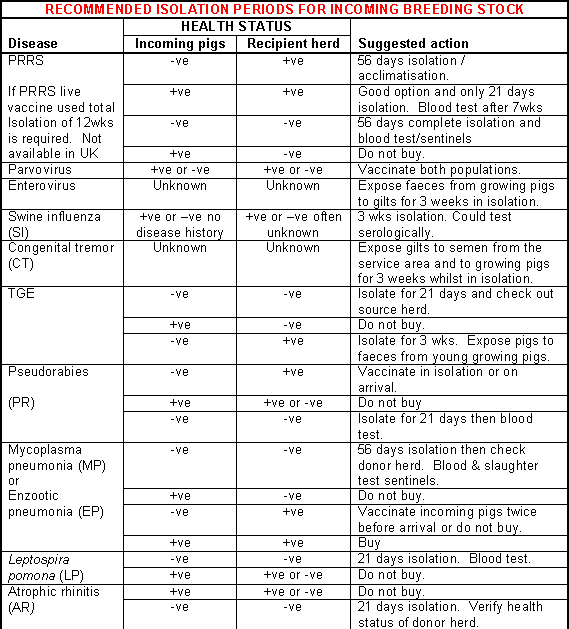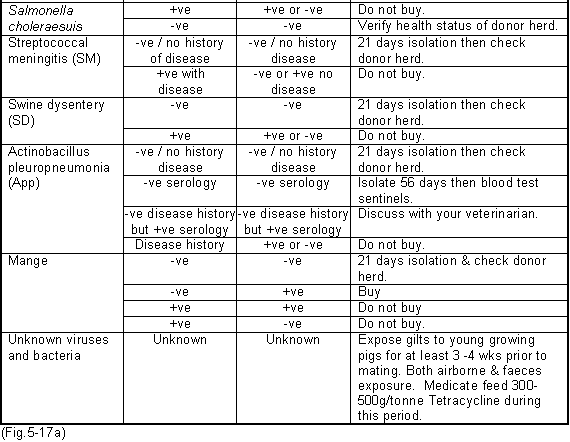



Acclimatisation of gilts
Gilts that you introduce to your herd from elsewhere must be acclimatised over a period of up to 6 to 8 weeks prior to mating. This acclimatisation allows the gilts to adjust to your feed, housing and management system but above all to those pathogenic organisms enzootic in your herd that they may have no immunity to. Major problems arise when gilts from high health status herds (e.g. a herd free from EP, App, PRRS, AD/PR, AR) are put straight into a herd in which these infections are present and active. The gilts become ill and fail to come in heat or fail to conceive. They may be made permanently infertile. In such cases vaccination of the gilts on arrival against, for e.g. EP, AD/PR, App and even in extreme cases H. parasuis, help the acclimatisation and possibly allow it to be shortened. A period of medicated feed - at half to three quarters therapeutic level may also help, say, for the first three weeks. Even when the incoming gilts are from a herd thought to be of similar status to your own, a minimum of three weeks acclimatisation is necessary.
If possible (and its not possible on many weaner producer farms) the incoming gilts should be segregated from the main herd for at least the first three weeks of acclimatisation. Some seedstock suppliers insist on this. It gives time to remove the gilts off your farm if disease breaks out in the source herd. The process of acclimatisation involves exposing the group of gilts to likely sources of virus or bacterial contamination. The exact procedures depend upon the diseases present in your herd compared with the herd of origin.
The following should be considered:
- Identify the diseases the gilt has been exposed to in the donor herd and those present in your herd.
- Decide whether the gilts move into isolation or direct into the herd. If the latter place them in a pen with separate drainage and air space for 4 to 6 weeks and use separate boots and protective clothing.
- Parvovirus - Vaccinate the gilts 2-3 weeks prior to mating additionally expose them to grower faeces (8-16 weeks of age). Place 3.3kg into the pen three times a week.
- Aujeszky's disease - Vaccinate on arrival.
- TGE - If gilts are naive vaccinate in isolation if your herd carries the virus or if no vaccine is available expose them to weaner faeces soon after arrival.
- Congenital tremor - Expose the gilts to faeces from the farrowing house three times a week. Wipe the vulva of recently served sows with tissues to collect semen secretions and place these in the pen three times a week.
- Rotavirus - Expose the gilts to weaner faeces three times a week.
- Atrophic rhinitis - Vaccinate on arrival.
- Erysipelas - Vaccinate on arrival.
- E. coli - Expose gilts three times a week to weaner and/or farrowing house faeces. Vaccinate during pregnancy.
- Leptospirosis - Vaccinate on arrival.
- Enzootic pneumonia - If the incoming pigs come from a herd free from EP vaccinate prior to arrival or well before if possible.
- Porcine reproductive respiratory syndrome - Where possible buy in sero-positive gilts into a sero-positive herd. If gilts are naive either vaccinate whilst in isolation on arrival or expose to an infected environment on the farm for one to two hours. A building containing pigs 6 to 12 weeks of age is ideal. Expose naive gilts to PRRS at six weeks prior to mating. An alternate is to house a small number of pigs in the isolation premises.
- Judge the result of acclimatisation by the response. Avoid using placenta for feed-back it can spread disease and may increase the risk of cannibalism a farrowing.
Isolation
A period of isolation is well advised to ensure that incoming gilts are not incubating disease. The actual farm procedures will vary from one to another.
The increases in herd sizes, the adoption of Segregated Early Weaning (SEW) and 3 site production, and the presence of PRRS have all focused attention on the best way to introduce gilts into the herd. Recommendations have in some ways reached fever pitch with all kinds of complex systems, time periods, isolation premises, a myriad of recommendations and a pig farmer left in confusion. However the main objectives should be:
- To prevent new diseases from entering the recipient herd.
- To establish procedures that result in a common immune status between the incoming pigs and the receiving herd without creating infection that disturbs the balance of infectious agents in the herd.
Preventing disease entry
- Assess specific diseases present in the receiving herd. Veterinarians should assess the disease compatibilities of both groups of pigs at the onset.
- Assess their significance in relation to the health status of the incoming stock.
- Use Fig.5-17a to identify the common diseases and the isolation periods that may be necessary.
- Isolation periods can be grouped into four time scales: none, 3 weeks, 8 weeks and 12 weeks, depending upon known incubation periods of different diseases.
- Isolation accommodation can be either on farm, or total separation from the herd by a minimum of 800m (1/2mile) with completely separate personnel.
- If isolation is on farm, incoming stock should be housed for a period of 21-56 days in their own air space and separate drainage. This provides the opportunity (but a risk) for the pigs to be removed if the donor herd reports a new disease not compatible at the onset.









